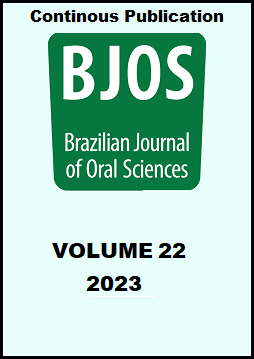Abstract
Oxidative stress is identified as the common pathogenic factor that leads to insulin resistance in diabetics. Malondialdehyde is a product of lipid peroxidation. Aim: The aim of this study was to determine the variation in the Salivary malondialdehyde (MDA) among subjects with and without T2DM in comparison to the fasting blood and Salivary glucose. Methods: This study involved 29 healthy participants as Controls (group I) and 29 participants with Type 2 Diabetes Mellitus as Cases (group II). Salivary Glucose was analysed by glucose oxidase end-point assay. Thiobarbituric acid (TBA) assay method was considered for estimation of MDA in fasting saliva. Data was Statistically analysed using SPSS20. Parametric test was performed to analyse the data. Results: The correlation calculated between FBG with FSG level was found to be highly significant. A positive correlation between MDA levels with FBG was found. The relationship between FBG and FSG (r = 0.7815, p < 0.05), FBG and MDA (r =0.3678, p < 0.05) and FSG and MDA (r = 0.2869, p < 0.05) were found to be positively significant. Conclusion: Saliva as a unique body fluid can serve as a medium for biochemical analysis only in standard settings and with multiple measures to be used as a diagnostic tool in par with the gold standard serum. Salivary MDA levels can be considered as one of the oxidative stress markers in Type 2 Diabetic condition.
References
Hansen T. Type 2 diabetes mellitus--a multifactorial disease. Ann Univ Mariae Curie Sklodowska Med. 2002;57(1):544-9.
Wu Y, Ding Y, Tanaka Y, Zhang W. Risk factors contributing to type 2 diabetes and recent advances in the treatment and prevention. Int J Med Sci. 2014 Sep;11(11):1185-200. doi: 10.7150/ijms.10001.
Nair A, Nair BJ. Comparative analysis of the oxidative stress and antioxidant status in type II diabetics and nondiabetics: A biochemical study. J Oral Maxillofac Pathol. 2017 Sep-Dec;21(3):394-401. doi: 10.4103/jomfp.JOMFP_56_16.
Diabetes Control and Complications Trial (DCCT): results of feasibility study. The DCCT Research Group. Diabetes Care. 1987 Jan-Feb;10(1):1-19. doi: 10.2337/diacare.10.1.1.
Asmat U, Abad K, Ismail K. Diabetes mellitus and oxidative stress-A concise review. Saudi Pharm J. 2016 Sep;24(5):547-53. doi: 10.1016/j.jsps.2015.03.013.
Fakhruddin S, Alanazi W, Jackson KE. Diabetes-Induced Reactive Oxygen Species: Mechanism of Their Generation and Role in Renal Injury. J Diabetes Res. 2017;2017:8379327. doi: 10.1155/2017/8379327.
Volpe CMO, Villar-Delfino PH, Dos Anjos PMF, Nogueira-Machado JA. Cellular death, reactive oxygen species (ROS) and diabetic complications. Cell Death Dis. 2018 Jan;9(2):119. doi: 10.1038/s41419-017-0135-z.
Birben E, Sahiner UM, Sackesen C, Erzurum S, Kalayci O. Oxidative stress and antioxidant defense. World Allergy Organ J. 2012 Jan;5(1):9-19. doi: 10.1097/WOX.0b013e3182439613.
Lee R, Margaritis M, Channon KM, Antoniades C. Evaluating oxidative stress in human cardiovascular disease: methodological aspects and considerations. Curr Med Chem. 2012;19(16):2504-20. doi: 10.2174/092986712800493057.
Al-Rawi NH. Oxidative stress, antioxidant status and lipid profile in the saliva of type 2 diabetics. Diab Vasc Dis Res. 2011 Jan;8(1):22-8. doi: 10.1177/1479164110390243.
Kilpatrick ES, Rigby AS, Atkin SL. Variability in the relationship between mean plasma glucose and HbA1c: implications for the assessment of glycemic control. Clin Chem. 2007 May;53(5):897-901. doi: 10.1373/clinchem.2006.079756.
Streckfus CF, Bigler LR. Saliva as a diagnostic fluid. Oral Dis. 2002 Mar;8(2):69-76. doi: 10.1034/j.1601-0825.2002.1o834.x.
Agrawal RP, Sharma N, Rathore MS, Gupta VB, Jain S, Agarwal V, et al. Noninvasive Method for Glucose Level Estimation by Saliva. J Diabetes Metab. 2013;4(5):1000266. doi:10.4172/2155-6156.1000266.
Navazesh M. Methods for collecting saliva. Ann N Y Acad Sci. 1993 Sep 20;694:72-7. doi: 10.1111/j.1749-6632.1993.tb18343.x.
Gupta S, Nayak MT, Sunitha JD, Dawar G, Sinha N, Rallan NS. Correlation of salivary glucose level with blood glucose level in diabetes mellitus. J Oral Maxillofac Pathol. 2017 Sep-Dec;21(3):334-9. doi: 10.4103/jomfp.JOMFP_222_15.
Baliga S, Chaudhary M, Bhat S, Bhansali P, Agrawal A, Gundawar S. Estimation of malondialdehyde levels in serum and saliva of children affected with sickle cell anemia. J Indian Soc Pedod Prev Dent. 2018 Jan-Mar;36(1):43-7. doi: 10.4103/JISPPD.JISPPD_87_17.
Tiongco RE, Bituin A, Arceo E, Rivera N, Singian E. Salivary glucose as a non-invasive biomarker of type 2 diabetes mellitus. J Clin Exp Dent. 2018 Sep;10(9):e902-e907. doi: 10.4317/jced.55009.
Mascarenhas P, Fatela B, Barahona I. Effect of diabetes mellitus type 2 on salivary glucose--a systematic review and meta-analysis of observational studies. PLoS One. 2014 Jul;9(7):e101706. doi: 10.1371/journal.pone.0101706.
Abdul-Ghani MA, DeFronzo RA. Plasma glucose concentration and prediction of future risk of type 2 diabetes. Diabetes Care. 2009 Nov;32 Suppl 2(Suppl 2):S194-8. doi: 10.2337/dc09-S309.
Ghazanfari Z, Haghdoost AA, Alizadeh SM, Atapour J, Zolala F. A Comparison of HbA1c and Fasting Blood Sugar Tests in General Population. Int J Prev Med. 2010 Summer;1(3):187-94.
Gupta S, Sandhu SV, Bansal H, Sharma D. Comparison of salivary and serum glucose levels in diabetic patients. J Diabetes Sci Technol. 2015 Jan;9(1):91-6. doi: 10.1177/1932296814552673.
Moebus S, Göres L, Lösch C, Jöckel KH. Impact of time since last caloric intake on blood glucose levels. Eur J Epidemiol. 2011 Sep;26(9):719-28. doi: 10.1007/s10654-011-9608-z.
Mahreen R, Mohsin M, Nasreen Z, Siraj M, Ishaq M. Significantly increased levels of serum malonaldehyde in type 2 diabetics with myocardial infarction. Int J Diabetes Dev Ctries. 2010 Jan;30(1):49-51. doi: 10.4103/0973-3930.60006.
Bhutia Y, Ghosh A, Sherpa ML, Pal R, Mohanta PK. Serum malondialdehyde level: Surrogate stress marker in the Sikkimese diabetics. J Nat Sci Biol Med. 2011 Jan;2(1):107-12. doi: 10.4103/0976-9668.82309.
Smriti K, Pai KM, Ravindranath V, Pentapati KC. Role of salivary malondialdehyde in assessment of oxidative stress among diabetics. J Oral Biol Craniofac Res. 2016 Jan-Apr;6(1):41-4. doi: 10.1016/j.jobcr.2015.12.004.
Kadashetti V, Baad R, Malik N, Shivakumar KM, Vibhute N, Belgaumi U, et al. Glucose level estimation in diabetes mellitus by saliva: a bloodless revolution. Rom J Intern Med. 2015 Jul-Sep;53(3):248-52. doi: 10.1515/rjim-2015-0032.
Javaid MA, Ahmed AS, Durand R, Tran SD. Saliva as a diagnostic tool for oral and systemic diseases. J Oral Biol Craniofac Res. 2016;6(1):66-75. doi: 10.1016/j.jobcr.2015.08.006.
Wong DT. Salivaomics. J Am Dent Assoc. 2012 Oct;143(10 Suppl):19S-24S. doi: 10.14219/jada.archive.2012.0339.

This work is licensed under a Creative Commons Attribution 4.0 International License.
Copyright (c) 2022 Sunila Bukanakere Sangappa, Tamal Das, Basavaraj Patil Preethi


